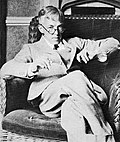In mathematics, the Hardy–Littlewood maximal operator M is a significant non-linear operator used in real analysis and harmonic analysis. The operator...
11 KB (1,859 words) - 19:31, 23 April 2025
Maximal functions appear in many forms in harmonic analysis (an area of mathematics). One of the most important of these is the Hardy–Littlewood maximal...
9 KB (1,467 words) - 13:37, 12 March 2024
maximal function Hardy–Littlewood tauberian theorem Hardy–Littlewood zeta function conjectures Hardy–Ramanujan Journal Hardy–Ramanujan number Hardy–Ramanujan...
33 KB (3,496 words) - 10:51, 3 May 2025
Hardy–Littlewood inequality Hardy–Littlewood maximal function Hardy–Littlewood zeta function conjectures Hardy–Littlewood tauberian theorem First Hardy–Littlewood...
15 KB (1,588 words) - 17:39, 21 November 2024
that the last integral is less than the value at eiθ of the Hardy–Littlewood maximal function φ∗ of the restriction of φ to the unit circle T, φ ∗ ( e i...
12 KB (1,833 words) - 03:15, 25 August 2023
a locally integrable function f—can be proved as a consequence of the weak–L1 estimates for the Hardy–Littlewood maximal function. The proof below follows...
11 KB (1,697 words) - 21:09, 10 July 2024
unbounded for p equal to 1 or ∞. Another famous example is the Hardy–Littlewood maximal function, which is only sublinear operator rather than linear. While...
9 KB (1,488 words) - 16:48, 27 March 2025
Riemann hypothesis (redirect from Hardy-Littlewood-Selberg-Levinson-Conrey theorem)
Hardy (1914) and Hardy & Littlewood (1921) showed there are infinitely many zeros on the critical line, by considering moments of certain functions related...
127 KB (16,742 words) - 22:11, 3 May 2025
the Hardy–Littlewood maximal operator is bounded on Lp(dω). Specifically, we consider functions f on Rn and their associated maximal functions M( f )...
11 KB (1,674 words) - 09:59, 22 May 2024
of function spaces arising naturally in analysis are Orlicz spaces. One such space L log+ L, which arises in the study of Hardy–Littlewood maximal functions...
12 KB (2,120 words) - 16:35, 5 April 2025
In mathematical analysis, the Hardy–Littlewood inequality, named after G. H. Hardy and John Edensor Littlewood, states that if f {\displaystyle f} and...
5 KB (1,126 words) - 21:12, 14 April 2025
H^{p}(\mathbb {D} )} is the Hardy space. The proof utilizes the symmetry of the Poisson kernel using the Hardy–Littlewood maximal function for the circle. The...
5 KB (1,055 words) - 22:21, 29 April 2025
the use of Poisson integrals, interpolation theory and the Hardy–Littlewood maximal function. For more general operators, fundamental new techniques, introduced...
70 KB (12,881 words) - 23:11, 6 February 2025
lemma is a lemma due to Frigyes Riesz, used in the proof of the Hardy–Littlewood maximal theorem. The lemma was a precursor in one dimension of the Calderón–Zygmund...
5 KB (573 words) - 05:49, 22 April 2025
integrable function and |B(x, r)| denotes the measure of the ball B(x, r). The Hardy–Littlewood maximal inequality states that for an integrable function f, |...
8 KB (1,281 words) - 14:35, 25 February 2025
Stein–Strömberg inequality is a result in measure theory concerning the Hardy–Littlewood maximal operator. The result is foundational in the study of the problem...
2 KB (310 words) - 21:14, 14 April 2025
e., as n → ∞ {\displaystyle n\to \infty } . This uses the Hardy–Littlewood maximal function. If ( k n ) {\displaystyle (k_{n})} is not radially decreasing...
4 KB (661 words) - 17:19, 1 September 2024
Lp space (redirect from P-integrable function)
{\displaystyle \lambda } the Lebesgue measure; the (nonlinear) Hardy–Littlewood maximal operator is bounded on L p ( R n , λ ) . {\displaystyle L^{p}(\mathbb...
65 KB (12,217 words) - 21:17, 14 April 2025
Wirtinger's inequality for functions Young's convolution inequality Young's inequality for products Hardy–Littlewood maximal inequality Inequality of arithmetic...
9 KB (709 words) - 21:10, 14 April 2025
J-invariant (redirect from Elliptic modular function)
{e^{4\pi {\sqrt {n}}}}{{\sqrt {2}}\,n^{3/4}}}} , as can be proved by the Hardy–Littlewood circle method. More remarkably, the Fourier coefficients for the positive...
27 KB (4,738 words) - 05:27, 2 May 2025
Lester E. (1963). "Sharp Bounds on the Distribution of the Hardy-Littlewood Maximal Function". Proceedings of the American Mathematical Society. 14 (3):...
15 KB (1,466 words) - 07:10, 6 May 2024
rearrangement inequality (1) is recovered. Hardy–Littlewood inequality Chebyshev's sum inequality Hardy, G.H.; Littlewood, J.E.; Pólya, G. (1952), Inequalities...
13 KB (2,621 words) - 21:14, 14 April 2025
Stein maximal principle (showing that under many circumstances, almost everywhere convergence is equivalent to the boundedness of a maximal function), Stein...
12 KB (1,002 words) - 16:05, 4 May 2025
proved by Kolmogorov–Seliverstov–Plessner for p = 2, by G. H. Hardy for p = 1, and by Littlewood–Paley for p > 1 (Zygmund 2002). This result had not been improved...
15 KB (1,792 words) - 13:46, 17 April 2025
distributions and Sato's hyperfunctions. Hardy-Littlewood maximal inequality The Hardy-Littlewood maximal function of f ∈ L 1 ( R n ) {\displaystyle f\in...
28 KB (4,340 words) - 07:40, 15 April 2025
Riesz–Thorin theorem (section Simple functions)
disadvantage is that, in practice, many operators, such as the Hardy–Littlewood maximal operator and the Calderón–Zygmund operators, do not have good endpoint...
39 KB (6,116 words) - 16:44, 27 March 2025
Hewitt–Savage zero–one law Law of truly large numbers Littlewood's law Infinite monkey theorem Littlewood–Offord problem Inclusion–exclusion principle Impossible...
11 KB (1,000 words) - 14:07, 2 May 2024
)x^{1/2-\varepsilon }} . Hardy–Littlewood zeta function conjectures Hilbert–Pólya conjecture: the nontrivial zeros of the Riemann zeta function correspond to eigenvalues...
195 KB (20,026 words) - 13:12, 7 May 2025
List of theorems (section Real functions)
(Banach algebra) Gelfand–Naimark theorem (functional analysis) Hardy–Littlewood maximal theorem (real analysis) Hellinger–Toeplitz theorem (functional...
78 KB (6,293 words) - 12:16, 2 May 2025
estimate of the prime-counting function. The evidence also seemed to indicate this. However, in 1914 J. E. Littlewood proved that this was not always...
35 KB (1,461 words) - 12:50, 10 May 2025







